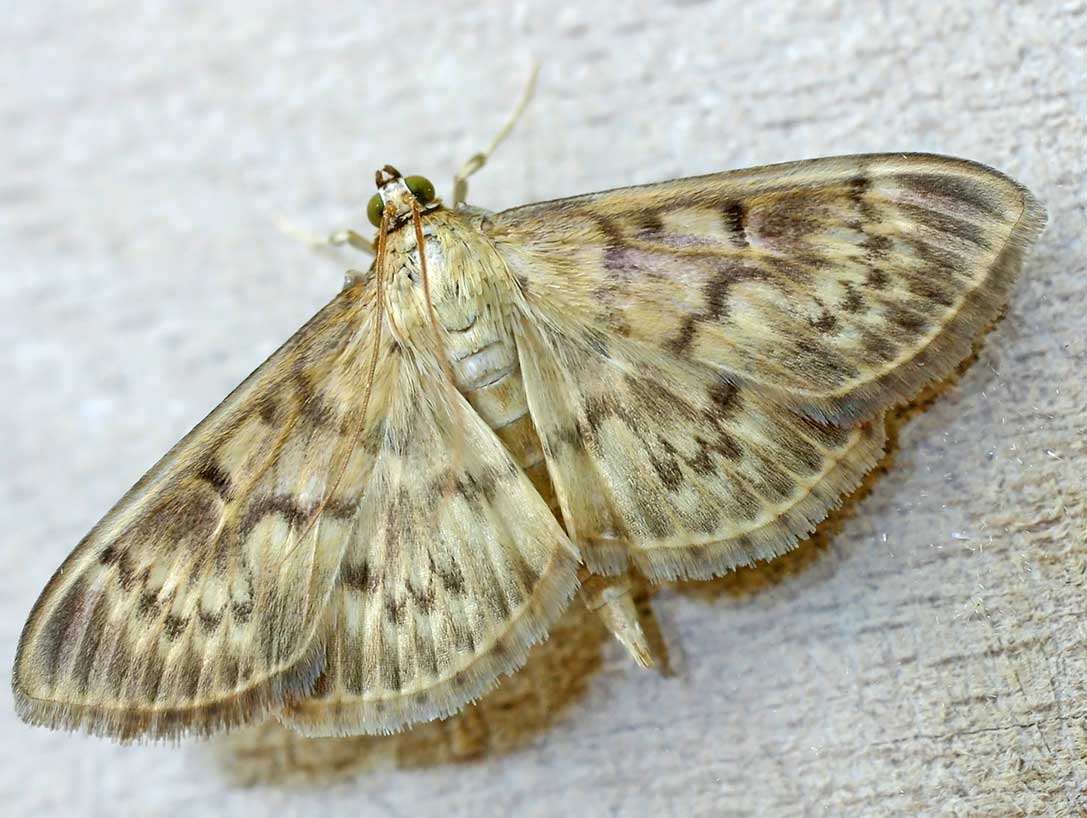- Spilomelinae
Taxobox
name = Spilomelinae

image_width = 240px
image_caption = Mother of Pearl, "Pleuroptya ruralis"
regnum =Animal ia
phylum =Arthropod a
classis =Insect a
ordo =Lepidoptera
subordo =Ditrysia
superfamilia =Pyraloidea
familia =Crambidae
subfamilia = Spilomelinae
subdivision_ranks = Genera
subdivision ="Arnia" "Pleuroptya " "Mecyna " "Agrotera" "Diasemia " "Diasemiopsis " "Duponchelia " "Spoladea " "Palpita " "Sceliodes " "Amaurophanes " "Dolicharthria " "Antigastra " "Metasia " "Nomophila " and see textSpilomelinae is a very large
subfamily of thelepidoptera n familyCrambidae , the crambid snoutmoth s. They were formerly included in thePyraustinae as tribe Spilpmelini; furthermore Taxonomists' opinions differ as to the correct placement of theCrambidae , some authorities treating them as a subfamily (Crambinae) of the familyPyralidae . If this is done, Spilomelinae is usually treated as a separate subfamily within Pyralidae. The Spilomelinae are believed to bepolyphyletic ; many genera are only tentatively placed here even at this point.With nearly 3,800 described species worldwide, this is the most speciose group among pyraloids. The moths are characterized by the absence of
chaetosemata , a bilobedpraecinctorium , projectingfornix tympani , pointedspinula , absence of agnathos , and the female genitalia have no rhomboidal signum on thebursa copulatrix .Genera tentatively referred to Spilomelinae
* "Aboetheta "
* "Acicys "
* "Aethaloessa "
* "Aetholix "
* "Agathodes "
* "Agrioglypta "
* "Anageshna "
* "Analyta "
* "Aphytoceros "
* "Apilocrocis "
* "Apogeshna "
* "Aporocosmus "
* "Araschnopsis "
* "Archernis "
* "Arthroschista "
* "Arxama "
* "Asciodes "
* "Ategumia "
* "Atelocentra "
* "Auchmophoba "
* "Azochis "
* "Bacotoma "
* "Bicilia "
* "Blepharomastix "
* "Bocchoris"
* "Botyodes "
* "Bradina "
* "Camptomastix "
* "Cangetta "
* "Caprinia "
* "Chabula "
* "Chalcidoptera "
* "Chilochroma "
* "Choristostigma "
* "Chrysothyridia "
* "Cirrhochrista "
* "Cissachroa "
* "Cnaphalocrocis "
* "Colomychus "
* "Compacta "
* "Conchylodes "
* "Condylorrhiza "
* "Conogethes "
* "Coptobasis "
* "Cotachena "
* "Criophthona "
* "Cryptobotys "
* "Cydalima "
* "Daulia"
* "Desmia "
* "Deuterarcha "
* "Deuterophysa "
* "Diacme "
* "Diaphania "
* "Diaphantania "
* "Diasemiodes "
* "Diastictis "
* "Diathrausta "
* "Dichocrocis "
* "Didymostoma "
* "Diplopseustis "
* "Dracaenura "
* "Dysallacta "
* "Ectadiosoma "
* "Epipagis "
* "Ercta "
* "Eudaimonisma "
* "Eulepte "
* "Eurrhyparodes "
* "Eurybela "
* "Eusabena "
* "Falcimorpha "
* "Filodes "
* "Framinghamia "
* "Geshna "
* "Glauconoe "
* "Glycythyma "
* "Glyphodes "
* "Haritalodes "
* "Herpetogramma "
* "Hoterodes "
* "Hydriris "
* "Hydropionea "
* "Hymenia "
* "Hymenoptychis "
* "Ischnurges "
* "Lamprosema "
* "Laniifera "
* "Leucinodes "
* "Leucochroma "
* "Lineodes "
* "Liopasia "
* "Lipararchis "
* "Loxomorpha "
* "Loxostegopsis "
* "Lygropia "
* "Lypotigris "
* "Macaretaera "
* "Macrobela "
* "Maracayia "
* "Maruca "
* "Meroctena "
* "Merodictya "
* "Metallarcha "
* "Metoeca "
* "Microthyris "
* "Mimophobetron "
* "Mimorista "
* "Myriostephes "
* "Myrmidonistis "
* "Nacoleia "
* "Nausinoe "
* "Neoleucinodes "
* "Niphograpta "
* "Nosophora "
* "Notarcha "
* "Omiodes "
* "Ommatospila "
* "Omphisa "
* "Orphanostigma "
* "Orphnophanes "
* "Orthospila "
* "Osiriaca "
* "Otiophora "
* "Pachynoa "
* "Palpusia "
* "Pantographa "
* "Pardomima "
* "Parotis "
* "Patania "
* "Penestola "
* "Perisyntrocha "
* "Phaedropsis "
* "Phostria "
* "Piletocera "
* "Pilocrocis "
* "Polygrammodes "
* "Prooedema "
* "Prophantis "
* "Prorodes "
* "Protonoceras "
* "Psara"
* "Pycnarmon "
* "Pygospila "
* "Rehimena "
* "Rhectocraspeda "
* "Rhectothyris "
* "Rhimphalea "
* "Rhimphaliodes "
* "Salbia "
* "Samea "
* "Sameodes "
* "Sathria "
* "Sedenia "
* "Sericophylla "
* "Sisyrophora "
* "Somatania "
* "Stemorrhages "
* "Steniodes "
* "Sufetula"
* "Syllepis "
* "Syllepte "
* "Symmoracma "
* "Synclera "
* "Syngamia "
* "Tabidia "
* "Talanga"
* "Tatobotys "
* "Terastia "
* "Tetridia "
* "Torqueola "
* "Trigonobela "
* "Tylostega "
* "Tyspanodes "
* "Voliba "
* "Zagiridia "
* "Zellerina "ee also
*
Visual gallery of Crambidae
*List of crambid genera
Wikimedia Foundation. 2010.
